Stabat Mater Luigiego Boccheriniego — muzyczna interpretacja tekstu średniowiecznej sekwencji
Stabat Mater by Luigi Boccherini — a musical interpretation of a Middle Age sequence text
Author(s): Renata Borowiecka
Subject(s): Music
Published by: Wydawnictwo Uniwersytetu Śląskiego
Summary/Abstract: Stabat Mater, a Middle Age sequence text was musically interpreted by different national-ity composers many times. The scene under the cross has become a universal art theme. Inthe Italian circle, around 70 musical interpretations of the work in question, including theone by Boccherini, were created in the 18th century. The phenomenon of such a big numberof compositions can be certainly connected with the importance of the subject-matter ofStabat Mater, but also with the function of this text in the Latin liturgy and hegemony of theseria opera which influenced other musical (also religious) genres or with the fame of com-position by Pergolesi from 1736.Luigi Boccherini composed two versions of Stabat Mater (1781 and 1800), however, thelatter is only the variant of the former enriched with two extra solo voices. Boccherini’s inter-pretation, on the one hand, constitutes a visible reference to Pergolesi’s work in terms of thetype of cast, way of shaping form and melodic line, choice of key (f-moll), and presents typi-cal features of the language used by the composer, e. g. symmetry of construction and pri-vacy on the other hand. The work is characterized by the atmosphere of intimacy. It isrelated to the type of cast the instruments of a delicate sound (bows) and vocal voices ofa clear tone, clear texture, dominance of small dynamics, notions of dolce, dolcissimo, soave,sotto voce (a mezza voce), and also morendo in the interpretation from 1800. The constructionof expression is built by means of a reference to a musical rhetoric, reflected both in themeans of shaping the form (the principle of varietas, diversified types of arias, includingcharacteristic ones, e.g. siciliana, serenada), the choice of key and the usage of rhetorical fig-ures adequate to its content. Out of 11 works (solo parts arias and recitations, as well asansamble ones duets and trios in the second version), the key elements for this type ofdramaturgy are exordium and conclusio and sections: III the first growth of emotions, centralVI, VII (paying attention to the most important characters of the poem Mother and Son),and X the last “explosion” of expression. Because of a relatively different coda interpretation,the end of the first version seems to be a quiet reflection and expression of a trustful re-quest: “make the soul give the grace of paradise”. The last texts in the second version, on theother hand, bring the type of apotheosis, emphasizing the message of man’s unshakablehope and faith in salvation through the cross.
Book: Muzyka religijna – między epokami i kulturami. T. 2
- Page Range: 178-198
- Page Count: 12
- Publication Year: 2009
- Language: Polish
- Content File-PDF

